R.J. Stowell's Blog: rjsomeone, page 59
September 6, 2018
I'm on this sci-fi kick... Five Years
Our focus a week or so back was the ten pinnacle moments in rock's history. The last post in the series asked that you, the reader, create your own moment - what moment instilled in you a lifelong love of rock 'n' roll.
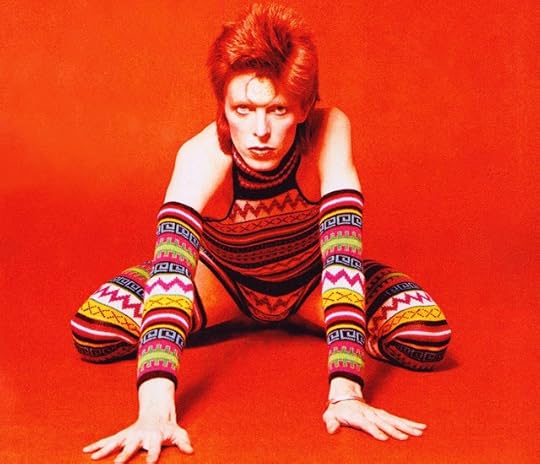
For this writer, Ziggy Stardust was the reason I do this today and why, for me, music is more than incidental. And while there is music that I appreciate more, even Bowie that I appreciate more (Hunky Dory, Diamond Dogs), Ziggy is the catalyst of my rapture. It's difficult to pinpoint why my choice wasn't Sgt. Pepper or The Monkees' Headquarters (or for that matter Bobby Vinton's Greatest Hits when I was five years old); these were the essential albums of my youth. I will venture to say that it was with Ziggy that I became introspective about music; that I began to analyze songs like this:
Of all Bowie’s dystopic and apocalyptic songs, "Five Years" is the most explicitly unsettling. One of the positive criticisms I get in my fiction (Yeah, yeah, Jay and the Americans) is that it's more about what is left unsaid; that it's all about the in-betweens. And so, we don't know why five years is all we've got, only that the planet has received a terminal prognosis and has to get its affairs in order. Ziggy's limited warning keeps his perspective on the street, on the masses who, having got the news, unravel. And yet there's an odd relief in the refrain of the track as if the misery-laden struggles of the mankind are finally over, indeed there is near celebration.
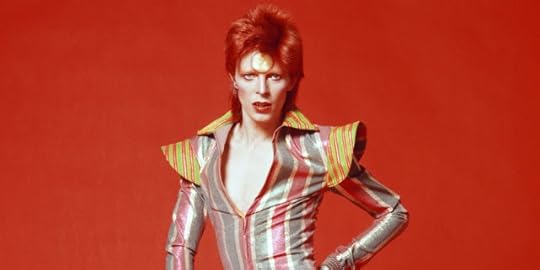
That Jubilation echoes "Memories of a Free Festival" from Space Oddity. While that song is a reflection of a Bowie performance at the Beckenham Arts Lab Free Festival on the day that his father died, there is a dystopian angst associated with it that alter the lyrics in a Five Years kind of way: "The sun machine is coming down and we’re gonna have a party."
In "Five Years," Bowie tapped into a current of pessimism and resignation that would define 1970s Britain in novels, films, music and real life. The Flower Power optimism in the 60stransmogrified into a 70s funk of hippie disillusionment amidst population bomb ecological nihilism - oh, oh, mercy, mercy me...
Bowie's tome mimicked a dystopian poem from 1967, Roger McGough's "At Lunchtime - A Love Story:
The buspeople, and there were many of them,
were shockedandsurprised and amused and annoyed, but when the
word got around that the world was coming to an end at
lunchtime, they put their pride in their pockets with their bustickets and
madelove one with the other.
The poem is set on a bus whose riders, learning the world will end at lunchtime, start having random sex. Watch it, a facsimile anyway, or read it here.
In "Five Years" the world has similarly turned upside-down. A "newsguy," forever emotionless and divorced from the everyday calamities of the world, openly weeps as he announces the impending catastrophe. Upon hearing the news, a policeman kneels to kiss the feet of a priest; we only had, after all, "five years left to cry in."
The inspiration underlying this philosophy had come from a dream Bowie had had in which he witnessed the reversal of the earth's electromagnetic field somewhere around the year 1977. For this reason, David refused to fly anywhere.
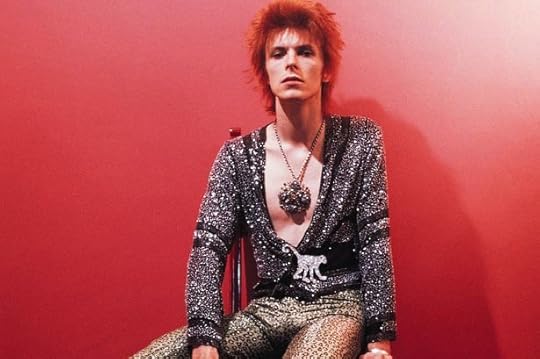
Assorted reactions to the impending disaster are observed and related humble narrator. Ziggy relates the plight of those around him: the fat-skinny, fall-short, nobody-somebody black soldier queer people. And yet, like in McGough's poem, the end, being nigh, brings a feeling of great optimism of what could and should be done. Bowie’s narrator makes his way through the desolate streets chronicling whatever he sees and only despairs when he remembers a friend (a former lover?) in an ice-cream shop, a moment of insignificance made unbearably poignant.
Consider the historical context of a world facing the real possibility of a nuclear apocalypse, and the tale of Ziggy Stardust and the Spiders from Mars begins to sound far less absurd. A suspenseful yet celebratory tone permeates the song, as though he and his band, the Spiders, had resigned themselves to their fate. The implication is that we should too. It's coming, they seem to proclaim, so why not enjoy it?

For this writer, Ziggy Stardust was the reason I do this today and why, for me, music is more than incidental. And while there is music that I appreciate more, even Bowie that I appreciate more (Hunky Dory, Diamond Dogs), Ziggy is the catalyst of my rapture. It's difficult to pinpoint why my choice wasn't Sgt. Pepper or The Monkees' Headquarters (or for that matter Bobby Vinton's Greatest Hits when I was five years old); these were the essential albums of my youth. I will venture to say that it was with Ziggy that I became introspective about music; that I began to analyze songs like this:
Of all Bowie’s dystopic and apocalyptic songs, "Five Years" is the most explicitly unsettling. One of the positive criticisms I get in my fiction (Yeah, yeah, Jay and the Americans) is that it's more about what is left unsaid; that it's all about the in-betweens. And so, we don't know why five years is all we've got, only that the planet has received a terminal prognosis and has to get its affairs in order. Ziggy's limited warning keeps his perspective on the street, on the masses who, having got the news, unravel. And yet there's an odd relief in the refrain of the track as if the misery-laden struggles of the mankind are finally over, indeed there is near celebration.

That Jubilation echoes "Memories of a Free Festival" from Space Oddity. While that song is a reflection of a Bowie performance at the Beckenham Arts Lab Free Festival on the day that his father died, there is a dystopian angst associated with it that alter the lyrics in a Five Years kind of way: "The sun machine is coming down and we’re gonna have a party."
In "Five Years," Bowie tapped into a current of pessimism and resignation that would define 1970s Britain in novels, films, music and real life. The Flower Power optimism in the 60stransmogrified into a 70s funk of hippie disillusionment amidst population bomb ecological nihilism - oh, oh, mercy, mercy me...
Bowie's tome mimicked a dystopian poem from 1967, Roger McGough's "At Lunchtime - A Love Story:
The buspeople, and there were many of them,
were shockedandsurprised and amused and annoyed, but when the
word got around that the world was coming to an end at
lunchtime, they put their pride in their pockets with their bustickets and
madelove one with the other.
The poem is set on a bus whose riders, learning the world will end at lunchtime, start having random sex. Watch it, a facsimile anyway, or read it here.
In "Five Years" the world has similarly turned upside-down. A "newsguy," forever emotionless and divorced from the everyday calamities of the world, openly weeps as he announces the impending catastrophe. Upon hearing the news, a policeman kneels to kiss the feet of a priest; we only had, after all, "five years left to cry in."
The inspiration underlying this philosophy had come from a dream Bowie had had in which he witnessed the reversal of the earth's electromagnetic field somewhere around the year 1977. For this reason, David refused to fly anywhere.

Assorted reactions to the impending disaster are observed and related humble narrator. Ziggy relates the plight of those around him: the fat-skinny, fall-short, nobody-somebody black soldier queer people. And yet, like in McGough's poem, the end, being nigh, brings a feeling of great optimism of what could and should be done. Bowie’s narrator makes his way through the desolate streets chronicling whatever he sees and only despairs when he remembers a friend (a former lover?) in an ice-cream shop, a moment of insignificance made unbearably poignant.
Consider the historical context of a world facing the real possibility of a nuclear apocalypse, and the tale of Ziggy Stardust and the Spiders from Mars begins to sound far less absurd. A suspenseful yet celebratory tone permeates the song, as though he and his band, the Spiders, had resigned themselves to their fate. The implication is that we should too. It's coming, they seem to proclaim, so why not enjoy it?
Published on September 06, 2018 04:48
September 3, 2018
Bowie - An Early History
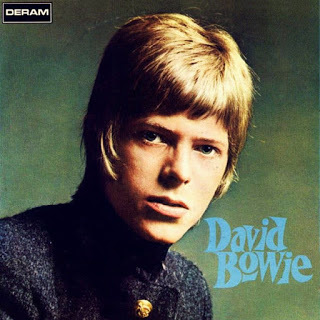 I guess one could go back to St. Mary's Church Choir in Bromley, 1958, for David Jones' first concert performance, but more legitimately (some would argue), Jones's first real concerts gigs were with The Konrads in 1962, The King Bees in January 1964, or The Manish Boys in March 1964. We'll start there. The Manish Boys were Davie Jones (vocals, sax), Johnny Flux (lead), John Watson (guitar, vocals), Bob Solly (organ), Paul Rodriguez (bass, trumpet), Wolfe Byrne (bari sax, harmonica) and Mike White (drums). Jones joined the band in '64 and for the next year, until March 1965, The Manish Boys (changing their name to Davy Jones and the Manish Boys in June) played a myriad of venues (in particular, a six date tour opening for Gerry and the Pacemakers in December 1964. Also on the bill were The Kinks, Gene Pitney and Marianne Faithful.) and cut their first and only record, "I Pity the Fool" b/w "Take My Tip" in March 1965. In April 1965, Jones joined established band The Lower Third, while continuing to play with The Manish Boys. In August 1965, Davie Jones and The Lower Third supported The Who in Bournemouth.
I guess one could go back to St. Mary's Church Choir in Bromley, 1958, for David Jones' first concert performance, but more legitimately (some would argue), Jones's first real concerts gigs were with The Konrads in 1962, The King Bees in January 1964, or The Manish Boys in March 1964. We'll start there. The Manish Boys were Davie Jones (vocals, sax), Johnny Flux (lead), John Watson (guitar, vocals), Bob Solly (organ), Paul Rodriguez (bass, trumpet), Wolfe Byrne (bari sax, harmonica) and Mike White (drums). Jones joined the band in '64 and for the next year, until March 1965, The Manish Boys (changing their name to Davy Jones and the Manish Boys in June) played a myriad of venues (in particular, a six date tour opening for Gerry and the Pacemakers in December 1964. Also on the bill were The Kinks, Gene Pitney and Marianne Faithful.) and cut their first and only record, "I Pity the Fool" b/w "Take My Tip" in March 1965. In April 1965, Jones joined established band The Lower Third, while continuing to play with The Manish Boys. In August 1965, Davie Jones and The Lower Third supported The Who in Bournemouth.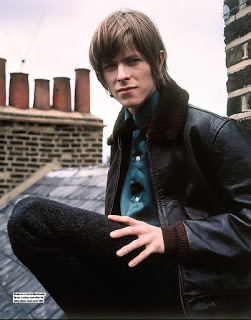 On September 16, 1965, Jones officially and legally changed his name to David Bowie to avoid any conflict with Oliver star (as The Artful Dodger) and Monkee Davy Jones. In February 1966, Bowie held auditions for his new band, tentatively called The Buzz; its members included John Hutchinson on guitar, Derek Fearnley on bass, John Eager on drums and Derrick Boyle on drums. Bowie, with backing from The Buzz would start a sojourn at the Marquee club in June 1966.
On September 16, 1965, Jones officially and legally changed his name to David Bowie to avoid any conflict with Oliver star (as The Artful Dodger) and Monkee Davy Jones. In February 1966, Bowie held auditions for his new band, tentatively called The Buzz; its members included John Hutchinson on guitar, Derek Fearnley on bass, John Eager on drums and Derrick Boyle on drums. Bowie, with backing from The Buzz would start a sojourn at the Marquee club in June 1966. This article does not effectively portray the number of dates played by Bowie exerting what would remain an unstoppable work ethic. Amidst gigs with The Lower Third and The Buzz, Bowie soloed with The Bill Saville Orchestra, performed a number of mime acts with a troupe called Turquoise, and played with The Strawbs, where he first met Rick Wakeman (Wakeman would go on to be instrumental on Hunky Dory, of course playing the piano on "Life on Mars").
Bowie's first album originally released in June 1967 is a pretty cool little record. How’s that for skirting the issue that while many debuts remain an artist's greatest effort (think Rickie Lee Jones, The Killers, The Beastie Boys)? If you like quirky mid-60's British pop, then you really can't go wrong here. "Join the Gang" is a rip on "Swinging London" and a personal fave. "Rubber Band" is a fun nostalgia trip on big bands during the Great War. "Uncle Arthur" is a silly song about the ultimate mama's boy. "When I Live My Dream" is generally considered the best song on the disc; it definitely seems the most mature. Even "Sell Me Your Coat" sounds cheerful though the poor guy is freezing to death. David will always be one of rock's greatest songwriters and lyricists and David Bowie has its fair share of hilarious stories of maids, transvestites, models in adverts, meglomaniacs, childhood fantasists and psychotic gravediggers. Not essential listening for 60's psychedelic enthusiasts but more for Bowie completists. In 1967 a 20-year-old genius was obviously having a blast giving commentary on both Mod London and Twentieth Century England in general.
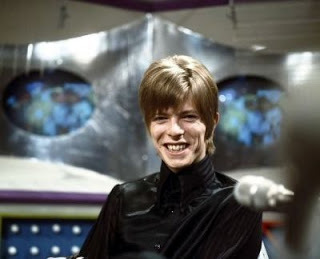 It's quite easy, and seemingly the accepted wisdom, to disregard the album, even pretend it doesn’t exist, yet there is an obvious fondness for narratives and character sketches that will blossom in years to come and define Bowie's ever shifting persona. Not exactly where one should start with Bowie, his debut album catches him with one foot in the past and one in the future. On the one hand, you have songs in an old-fashioned “easy listening” style with interesting, off-beat lyrics, and on the other you have tracks tied in with the trends of the day - whether the mild psych of "Join the Gang" or the orchestal-trippy "Silly Boy Blue" - with stilted, cliched lyrics.
It's quite easy, and seemingly the accepted wisdom, to disregard the album, even pretend it doesn’t exist, yet there is an obvious fondness for narratives and character sketches that will blossom in years to come and define Bowie's ever shifting persona. Not exactly where one should start with Bowie, his debut album catches him with one foot in the past and one in the future. On the one hand, you have songs in an old-fashioned “easy listening” style with interesting, off-beat lyrics, and on the other you have tracks tied in with the trends of the day - whether the mild psych of "Join the Gang" or the orchestal-trippy "Silly Boy Blue" - with stilted, cliched lyrics.David Bowie is s a pleasant enough listen; other favorites are probably the cross-dressing rock story "She's Got Medals" or the nostalgia-inducing "There Is a Happy Land" (though the latter's a guilty pleasure, considering how sappy it is), not to mention the gloomy poetry of "Please, Mr Gravedigger." It's just that Bowie's still trying to work out who he is and what he wants to do. His recording track record is similar to that of his extensive touring.
Most of us will begin our journey with Bowie on Space Oddity, where the alien truly finds his voice, but also reveals his chameleon-like nature, one that next would explore early heavy metal with The Man Who Sold the World. Years after his debut release, when Bowie became Ziggy and ruled the world, he may have been a bit embarrassed by this record. However, fans of folky, campy rock will enjoy, if only once.
Published on September 03, 2018 05:09
September 2, 2018
You Better Hang On To Yourself
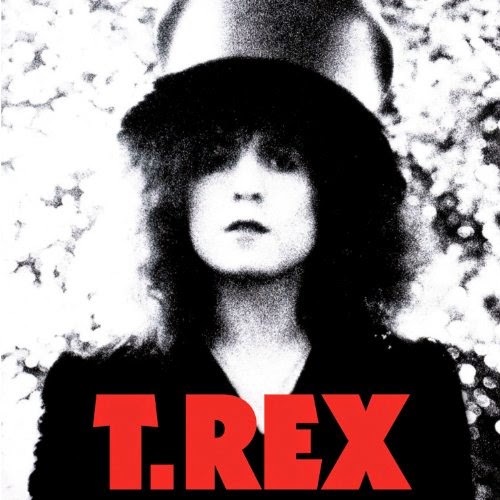 Glam rock, or glitter rock, emerged in the early 70s, a post-hippie phenomenon and antidote to all the earnest seriousness of the era. The dream was over, the stars burnt out and from the smoke of Altamont, came what? A teenaged transvestite revolution? Science fiction kabuki escapism? Exactly what the doctor ordered! There was still a sense of realism, a Hemingway sensibility in the U.S., but in England it was time to grasp the new decade with reckless abandon.
Glam rock, or glitter rock, emerged in the early 70s, a post-hippie phenomenon and antidote to all the earnest seriousness of the era. The dream was over, the stars burnt out and from the smoke of Altamont, came what? A teenaged transvestite revolution? Science fiction kabuki escapism? Exactly what the doctor ordered! There was still a sense of realism, a Hemingway sensibility in the U.S., but in England it was time to grasp the new decade with reckless abandon.The first artists to bridge the gap from hippies to glitter kids were the inimitable David Bowie and one time male model, Marc Bolan. Bolan, who for all intents and purposes was T. Rex, more or less invented glam rock in 1971 as the first to wear feather boas and top hats and to write songs not meant to be taken seriously. Dialing back the "freak-folk" of his first band, John's Children, and the original incarnation called Tyrannosaurus Rex, while adding an electrified Chuck Berry groove to his Tolkien tales, Marc Bolan rocked glitter and boas like few others. Appearing on Top of the Pops to sing his hit "Hot Love," Bolan created an instant sensation, in the process inspiring every artist on the glam docket.
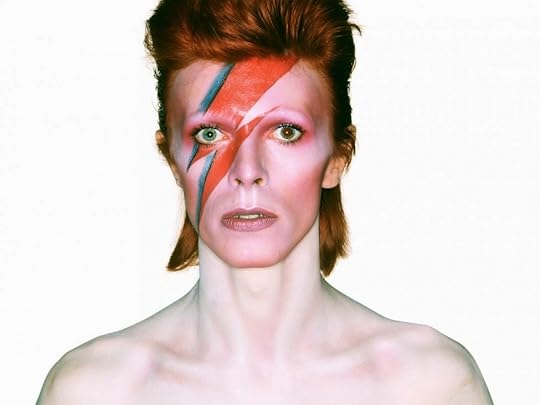 Like Bob Marley and reggae or Dylan and folk, David Bowie embodied the glam scene while simultaneously rising above it, creating his "Ziggy Stardust" persona after watching Bolan's career take off with a similar concept. Bowie had been a hippie folkie of sorts, particularly with 1969’s Space Oddity LP, but Marc's template appealed to both Bowie's theatrical side and his love for the simple, stripped-down rock 'n' roll also embodied by American friend, Lou Reed. The combination did for Bowie what it couldn't do for Bolan: it made him a star in the U.S. And while Bowie soon transmogrified into the Thin White duke, a blue-eyed soulster, a new wave experiment, even an EDM artist, it's his glam period people think of first when assessing his legacy. (See the Ziggy review in an earlier post.)
Like Bob Marley and reggae or Dylan and folk, David Bowie embodied the glam scene while simultaneously rising above it, creating his "Ziggy Stardust" persona after watching Bolan's career take off with a similar concept. Bowie had been a hippie folkie of sorts, particularly with 1969’s Space Oddity LP, but Marc's template appealed to both Bowie's theatrical side and his love for the simple, stripped-down rock 'n' roll also embodied by American friend, Lou Reed. The combination did for Bowie what it couldn't do for Bolan: it made him a star in the U.S. And while Bowie soon transmogrified into the Thin White duke, a blue-eyed soulster, a new wave experiment, even an EDM artist, it's his glam period people think of first when assessing his legacy. (See the Ziggy review in an earlier post.) This was the era that spawned The New York Dolls, Lou Reed’s Transformer, Slade, Sparks, The Sweet, Mott the Hoople and Roxy Music, the epitome of jaded androgynous style and European cool. One of the best, if not the very best, bands to come out of the 70s, Roxy Music were rock's last great innovators - on an epic scale; the sound they developed was the Lapis Lazuli to virtually every new musical genre originated since then. Their music can be roughly divided into two periods: the first two Brian Eno-dominated albums and everything else afterwards when the band's sound was dominated by Bryan Ferry's sultry croon. While the Eno albums do strike one as significantly different from the later stuff, one soon realizes that this difference has a purely technological character: the real heart of the band has always been Ferry.
This was the era that spawned The New York Dolls, Lou Reed’s Transformer, Slade, Sparks, The Sweet, Mott the Hoople and Roxy Music, the epitome of jaded androgynous style and European cool. One of the best, if not the very best, bands to come out of the 70s, Roxy Music were rock's last great innovators - on an epic scale; the sound they developed was the Lapis Lazuli to virtually every new musical genre originated since then. Their music can be roughly divided into two periods: the first two Brian Eno-dominated albums and everything else afterwards when the band's sound was dominated by Bryan Ferry's sultry croon. While the Eno albums do strike one as significantly different from the later stuff, one soon realizes that this difference has a purely technological character: the real heart of the band has always been Ferry.Though his contributions were colossal, Eno's departure, as he himself admitted, helped Roxy become a more focused, energized band. Eno helped Ferry morph his songs into referential collages and eerie synthscapes and that experimentation gave early Roxy their identity. Eno is easier to spot on Roxy's flashy, daring self-titled 1972 debut (the inventiveness of songs like "Ladytron" and "The Bob (Medley)" help to cover up rattly production values), but For Your Pleasure is a greater testament to Eno's importance. It's hard to imagine an album that better exploits the tensions between two fast-diverging creativities.
While T.Rex and Bowie created their music from out of the personas they'd become, Roxy Music created personas from out of the music. Though the end result was the same, the difference was evident and a key distinction in the evolution of glam.
Just a few AM classics from the Glam era:
David Bowie: Ziggy Stardust and the Spiders From Mars, Aladdin Sane, Diamond Dogs
Lou Reed: Transformer
Roxy Music: Stranded, For Your Pleasure, Country Life
T.Rex: The Slider
Eno: Here Come the Warm Jets
Published on September 02, 2018 04:28
August 31, 2018
Roxy Art
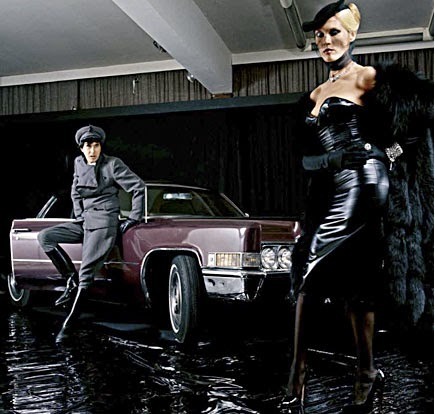 Though not as iconic as Sgt. Pepper or Tommy, the first five Roxy Music album covers are legendary. The first cover model, Kari-Ann Muller, got paid but 20 pounds, as Roxy was unknown at the time. Later she played in the Bond film On Her Majesty’s Secret Service. "Ironic," she said, "that it would be considered the best record cover of the decade." Doubt it, nonetheless.
Though not as iconic as Sgt. Pepper or Tommy, the first five Roxy Music album covers are legendary. The first cover model, Kari-Ann Muller, got paid but 20 pounds, as Roxy was unknown at the time. Later she played in the Bond film On Her Majesty’s Secret Service. "Ironic," she said, "that it would be considered the best record cover of the decade." Doubt it, nonetheless.Amanda Lear was the model on For Your Pleasure. Not only did she pose for Paco Rabanne, Yves Saint Laurent, Chanel, and Mary Quant, she also was the confidante and mistress of Salvador Dali. Lear was romantically linked to Brian Jones, which resulted in the ironic Rolling Stones track "Miss Amanda Jones." In 1973 she was briefly engaged to Bryan Ferry and went on to have a year-long affair with a married David Bowie. Marilyn Cole appeared on the third album Stranded. She started her career as a model for Playboy in 1972 and 1973.
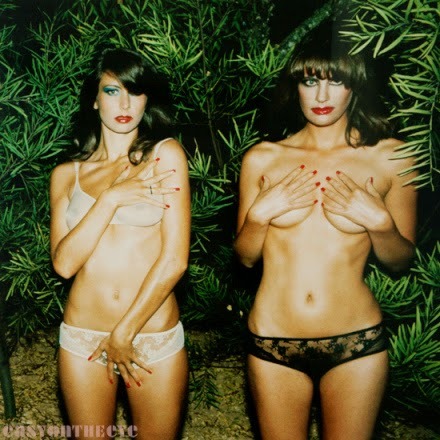 The title of the fourth Roxy album, Country Life, was a parody of a well-known British rural magazine of the same name. The front cover photo featured two models (two German fans, Constanze Karoli and Eveline Grunwald) clad only in lingerie, standing in a forest. As a result, in the U.S. the album was sold in an opaque plastic wrapper because retailers refused to display the cover. Later, and until we regained our senses, an alternate cover featuring just a shot of the forest was used, you know, 'cuz forests are, you know, hot. The cover, credited to Bryan Ferry and Nick DeVille, was shot in Portugal where Ferry was working on lyrics for the album during a recording break. Each issue of the magazine featured a demure image of one of the daughters of the aristocracy as a frontispiece, and Ferry liked the idea of trying to subvert this by using a more overtly soft-core girly-calendar image, inspired by a photo he'd seen in an issue of Men Only magazine.
The title of the fourth Roxy album, Country Life, was a parody of a well-known British rural magazine of the same name. The front cover photo featured two models (two German fans, Constanze Karoli and Eveline Grunwald) clad only in lingerie, standing in a forest. As a result, in the U.S. the album was sold in an opaque plastic wrapper because retailers refused to display the cover. Later, and until we regained our senses, an alternate cover featuring just a shot of the forest was used, you know, 'cuz forests are, you know, hot. The cover, credited to Bryan Ferry and Nick DeVille, was shot in Portugal where Ferry was working on lyrics for the album during a recording break. Each issue of the magazine featured a demure image of one of the daughters of the aristocracy as a frontispiece, and Ferry liked the idea of trying to subvert this by using a more overtly soft-core girly-calendar image, inspired by a photo he'd seen in an issue of Men Only magazine.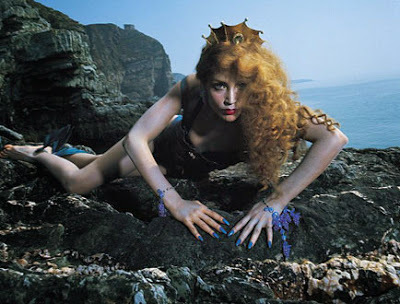 The most famous model was Jerry Hall, one of the original supermodels of the seventies. She began her career in Paris and in 1975 appeared, in the guise of a mermaid, on the cover of Siren. Five months later, she was engaged to Bryan Ferry. Her relationship with Ferry continued and she appeared in the video for his 1976 solo hit "Let’s Stick Together." By 1977, Hall had been on hundreds of magazine covers including Italian Vogue and Cosmopolitan. That same year, she met Mick Jagger at a dinner party, for whom she would eventually leave Bryan Ferry. What a tangled web. The Rolling Stones song "Miss You" was written by Mick Jagger for Jerry Hall. Each of the photos above are alternate takes of the famous Roxy covers.
The most famous model was Jerry Hall, one of the original supermodels of the seventies. She began her career in Paris and in 1975 appeared, in the guise of a mermaid, on the cover of Siren. Five months later, she was engaged to Bryan Ferry. Her relationship with Ferry continued and she appeared in the video for his 1976 solo hit "Let’s Stick Together." By 1977, Hall had been on hundreds of magazine covers including Italian Vogue and Cosmopolitan. That same year, she met Mick Jagger at a dinner party, for whom she would eventually leave Bryan Ferry. What a tangled web. The Rolling Stones song "Miss You" was written by Mick Jagger for Jerry Hall. Each of the photos above are alternate takes of the famous Roxy covers.
Published on August 31, 2018 04:17
August 29, 2018
What's Her Name, Virginia Plain
Virginia Plain - Roxy Music (AM10)
Lead singer Bryan Ferry took the song's title from a painting he did as an art student titled "Virginia Plain." It featured a huge pack of Virginia Slims cigarettes with a picture of Andy Warhol superstar Baby Jane Holzer standing in the middle of a plain. How could there not be a song in that?
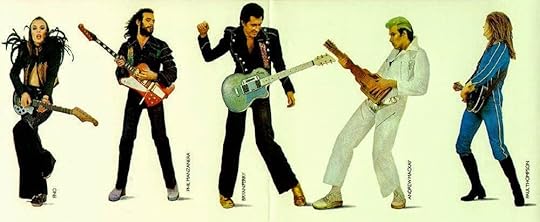
Make me a deal and make it straightAll signed and sealed, I'll take it
To Robert E. Lee I'll show it
I hope and pray he won't blow it cuz
We've been around a long time
Trying, just trying, just trying to make the big time
Take me on a roller coasterTake me for an airplane rideTake me on a six day wonder, but don't youDon't you throw my pride aside, besidesWhat's real and make-believe?Baby Jane's in Acapulco, we are flying down to Rio
Throw me a line, I'm sinking fastClutching at straws, can't make itHavana sound we're tryingA hard edge, a hipster jivingLast picture show's down the drive-inYou're so sheer, you're so chic, teenage rebel of the week
Pictures of the mountain streamlineMidnight blue casino floorsDance the Cha-Cha through till sunriseOpens up exclusive doors, butJust like flamingoes look the sameSo me and you, just we two, got to reach for something new
Far beyond the pale horizonSomewhere near the desert strandWhere my Studebaker takes meThat's where I'll make my stand, but wait!Can't you see her Holzer mane?What's her name?Virginia Plain
Lead singer Bryan Ferry took the song's title from a painting he did as an art student titled "Virginia Plain." It featured a huge pack of Virginia Slims cigarettes with a picture of Andy Warhol superstar Baby Jane Holzer standing in the middle of a plain. How could there not be a song in that?

Make me a deal and make it straightAll signed and sealed, I'll take it
To Robert E. Lee I'll show it
I hope and pray he won't blow it cuz
We've been around a long time
Trying, just trying, just trying to make the big time
Take me on a roller coasterTake me for an airplane rideTake me on a six day wonder, but don't youDon't you throw my pride aside, besidesWhat's real and make-believe?Baby Jane's in Acapulco, we are flying down to Rio
Throw me a line, I'm sinking fastClutching at straws, can't make itHavana sound we're tryingA hard edge, a hipster jivingLast picture show's down the drive-inYou're so sheer, you're so chic, teenage rebel of the week
Pictures of the mountain streamlineMidnight blue casino floorsDance the Cha-Cha through till sunriseOpens up exclusive doors, butJust like flamingoes look the sameSo me and you, just we two, got to reach for something new
Far beyond the pale horizonSomewhere near the desert strandWhere my Studebaker takes meThat's where I'll make my stand, but wait!Can't you see her Holzer mane?What's her name?Virginia Plain
Published on August 29, 2018 06:12
August 25, 2018
RTF - Romantic Warrior
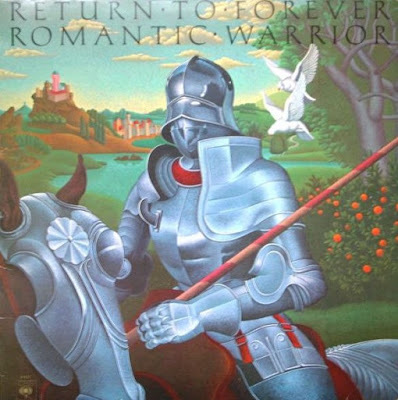 In February 1976, Return to Forever headed to Chicago producer James Guercio's popular and isolated Caribou Ranch in a remote part of Colorado to record Romantic Warrior. It's a fusion classic and, coming out of 1976, surely one of the genre's final highlights. Placing their musical topography somewhere in the middle ages, RTF rethinks its strategy to be more large-scale and consciously more musical; an electrically-charged Ellingtonian statement that's like a soundtrack for a non-existent film or an electronic symphony for a post-jazz age.
In February 1976, Return to Forever headed to Chicago producer James Guercio's popular and isolated Caribou Ranch in a remote part of Colorado to record Romantic Warrior. It's a fusion classic and, coming out of 1976, surely one of the genre's final highlights. Placing their musical topography somewhere in the middle ages, RTF rethinks its strategy to be more large-scale and consciously more musical; an electrically-charged Ellingtonian statement that's like a soundtrack for a non-existent film or an electronic symphony for a post-jazz age.The same group that cut its previous Where Have I Known You Before and No Mystery is reprised here — Romantic Warrior features strong originals from all principals, including Lenny White's "Sorceress," Al Di Meola's "Majestic Dance," Stanley Clarke's "The Magician" and Chick Corea's "Medieval Overture," "The Romantic Warrior" and "Duel of the Jester and the Tyrant."
For me, it went down like this. While riding in a van one day in the later '70s, Pete Felder stuck in an 8-track tape and said,"Dude, listen to this guitar." After 10 minutes, I was finally able to close my frozen jaw and wipe the drool from my chin and I asked him if I could borrow it; Felder didn't get it back until I bought the album. And it wasn't just the guitarist - the bassist blew me away! And all the synthesizers that complimented everything so perfectly. Of course, it wasn't just the musicianship and cool sounds either, the weed was excellente, but you didn't need to be high to get it. Today, I still feel like I'm sitting in front of an old console stereo. That clear, warm production drew me in as much as anything.
I've been writing about music for nearly 40 years, but nothing ever grabbed me like that day in the van. In a time when disco ruled, what a dramatic departure to discover a collection of baroque tunes played at breakneck speed on rock 'n' roll instruments full of funk and experimentation. A huge chunk of great music from the last 40 years exists because of this album. And most people don't even know that RTF ever existed.
Published on August 25, 2018 20:07
August 24, 2018
Jaco Pastorius
When Jaco Pastorius first met Joe Zawinul, the keyboardist and composer behind Weather Report, he had his introduction ready. "My name is John Francis Pastorius III," he said, as Zawinul later remembered. "I'm the greatest bass player in the world." Zawinul didn't bite that time out, but after receiving an early mix of Jaco's solo album, he decided to call on the bassist in late 1975. Jaco joined the group and played on two tracks on Weather Report's Black Market: "Cannonball," and his own “Barbary Coast.” 1976 would prove a watershed year.
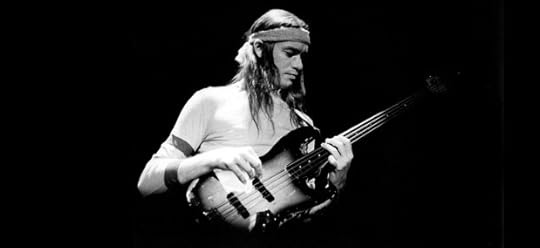
In 1976, Jaco Pastorius hadn't quite emerged from nowhere, (the few prior recordings on which he could be found may have provided some hint of what was to come), but it was the quadruple punch of fellow legend-in-the-making Pat Metheny's debut Bright Size Life,singer/songwriter Joni Mitchell's classic Hejira, fusion super group Weather Report's Black Market and, most notably, the bassist's own Jaco Pastorius, whose opening track—a duet look at Charlie Parker's "Donna Lee" with percussionist Don Alias that spoke of instrumental mastery and remarkable conceptual sophistication—that caused bassists around the world to look up from their instruments. Who was this guy? Where did he come from?
Pastorius's daring, technically precise electric-bass playing revealed his vision for the instrument that went beyond its traditional supportive position with a taste for counterpoint, the pursuit of melody and a readiness to cross genres. He issued three studio albums during his lifetime and formed several novel bands under the Word of Mouth banner, energized Weather Report when he joined the group in 1976, and was partner to Joni Mitchell from Hejira in 1976 to the incredible double live LP Shadows and Light in 1980.
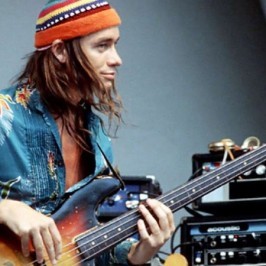 In Musician magazine, Joni said, "I know he stretched me. I stretched him some too, inadvertently, on things like Don Juan's Reckless Daughter. That was Alexandro Acuna, Don Alias, myself and Jaco. Alex's background is in Latin music, so that track was getting a very Latin percussion sound on the bottom. I said, "No , this is more North American Indian, a more limited palette of drum sounds." So Jaco got an idea. I don't know if he detuned his bass, but he started striking the end of the strings, up by the bridge, and he'd slide with the palm of his palm all the way down to the head. He set up this pattern: du du du doom, du du du doom. Well, it's a five minute song, and three minutes into it his hand started to bleed. He shredded it making it slide the full length of his bass strings. They turned into a grater. So we stopped tapping and he changed to his Venus mound, below the thumb. And when we finished the take, that was bleeding, too. So his whole hand was bleeding. But the music was magnificent, and he was so excited because he'd discovered a new thing. Later he built up calluses and you'd always see him doing those slides. But then he was mad with me because I had copped his new shit for my record! I think he might have had a different pain threshold."
In Musician magazine, Joni said, "I know he stretched me. I stretched him some too, inadvertently, on things like Don Juan's Reckless Daughter. That was Alexandro Acuna, Don Alias, myself and Jaco. Alex's background is in Latin music, so that track was getting a very Latin percussion sound on the bottom. I said, "No , this is more North American Indian, a more limited palette of drum sounds." So Jaco got an idea. I don't know if he detuned his bass, but he started striking the end of the strings, up by the bridge, and he'd slide with the palm of his palm all the way down to the head. He set up this pattern: du du du doom, du du du doom. Well, it's a five minute song, and three minutes into it his hand started to bleed. He shredded it making it slide the full length of his bass strings. They turned into a grater. So we stopped tapping and he changed to his Venus mound, below the thumb. And when we finished the take, that was bleeding, too. So his whole hand was bleeding. But the music was magnificent, and he was so excited because he'd discovered a new thing. Later he built up calluses and you'd always see him doing those slides. But then he was mad with me because I had copped his new shit for my record! I think he might have had a different pain threshold."
In 1987, after a night of not-atypical misadventure, Pastorius, who suffered from bipolar disorder exacerbated by drug abuse, was killed by a bouncer who beat him mercilessly.

In 1976, Jaco Pastorius hadn't quite emerged from nowhere, (the few prior recordings on which he could be found may have provided some hint of what was to come), but it was the quadruple punch of fellow legend-in-the-making Pat Metheny's debut Bright Size Life,singer/songwriter Joni Mitchell's classic Hejira, fusion super group Weather Report's Black Market and, most notably, the bassist's own Jaco Pastorius, whose opening track—a duet look at Charlie Parker's "Donna Lee" with percussionist Don Alias that spoke of instrumental mastery and remarkable conceptual sophistication—that caused bassists around the world to look up from their instruments. Who was this guy? Where did he come from?
Pastorius's daring, technically precise electric-bass playing revealed his vision for the instrument that went beyond its traditional supportive position with a taste for counterpoint, the pursuit of melody and a readiness to cross genres. He issued three studio albums during his lifetime and formed several novel bands under the Word of Mouth banner, energized Weather Report when he joined the group in 1976, and was partner to Joni Mitchell from Hejira in 1976 to the incredible double live LP Shadows and Light in 1980.
 In Musician magazine, Joni said, "I know he stretched me. I stretched him some too, inadvertently, on things like Don Juan's Reckless Daughter. That was Alexandro Acuna, Don Alias, myself and Jaco. Alex's background is in Latin music, so that track was getting a very Latin percussion sound on the bottom. I said, "No , this is more North American Indian, a more limited palette of drum sounds." So Jaco got an idea. I don't know if he detuned his bass, but he started striking the end of the strings, up by the bridge, and he'd slide with the palm of his palm all the way down to the head. He set up this pattern: du du du doom, du du du doom. Well, it's a five minute song, and three minutes into it his hand started to bleed. He shredded it making it slide the full length of his bass strings. They turned into a grater. So we stopped tapping and he changed to his Venus mound, below the thumb. And when we finished the take, that was bleeding, too. So his whole hand was bleeding. But the music was magnificent, and he was so excited because he'd discovered a new thing. Later he built up calluses and you'd always see him doing those slides. But then he was mad with me because I had copped his new shit for my record! I think he might have had a different pain threshold."
In Musician magazine, Joni said, "I know he stretched me. I stretched him some too, inadvertently, on things like Don Juan's Reckless Daughter. That was Alexandro Acuna, Don Alias, myself and Jaco. Alex's background is in Latin music, so that track was getting a very Latin percussion sound on the bottom. I said, "No , this is more North American Indian, a more limited palette of drum sounds." So Jaco got an idea. I don't know if he detuned his bass, but he started striking the end of the strings, up by the bridge, and he'd slide with the palm of his palm all the way down to the head. He set up this pattern: du du du doom, du du du doom. Well, it's a five minute song, and three minutes into it his hand started to bleed. He shredded it making it slide the full length of his bass strings. They turned into a grater. So we stopped tapping and he changed to his Venus mound, below the thumb. And when we finished the take, that was bleeding, too. So his whole hand was bleeding. But the music was magnificent, and he was so excited because he'd discovered a new thing. Later he built up calluses and you'd always see him doing those slides. But then he was mad with me because I had copped his new shit for my record! I think he might have had a different pain threshold." In 1987, after a night of not-atypical misadventure, Pastorius, who suffered from bipolar disorder exacerbated by drug abuse, was killed by a bouncer who beat him mercilessly.
Published on August 24, 2018 04:54
August 23, 2018
Court and Spark
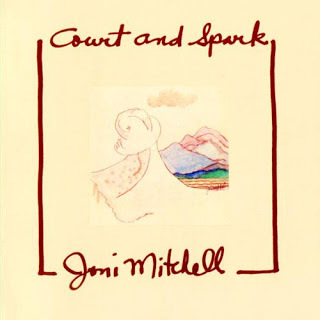 Although Court and Spark features some of Joni Mitchell's most accessible songs, you don't dance or party to Joni Mitchell. Court and Spark is nearly embarrassing to listen to with others. It is so personal that it feels like a private conservation. In the title track, Joni describes her narrow escape from a bad relationship with inexplicable candor:
Although Court and Spark features some of Joni Mitchell's most accessible songs, you don't dance or party to Joni Mitchell. Court and Spark is nearly embarrassing to listen to with others. It is so personal that it feels like a private conservation. In the title track, Joni describes her narrow escape from a bad relationship with inexplicable candor:He seemed like he read my mindHe saw me mistrusting him and still acting kindHe saw how I worried some timesI worry sometimes.
In "Car on A Hill," she awaits a lover (the same lover?) who is three hours late and looking the no-show. Wondering where he is and what he might be doing, she reflects on the impermanence of infatuation, recalling how "It always seems so righteous at the start,/ When there’s so much laughter,/ When there's so much spark,/ When there’s so much sweetness in the dark." But Mitchell's vulnerability never evokes pity. It makes one wonder why the dude kept her waiting.
Beyond the surface relationship in the song, those same lines foreshadow Mitchell’s disillusionment with success. Like many artists, having finally achieved popular and critical success with Court and Spark, Joni immediately began to challenge her fans' commitment with a series of jazz infused and certainly less accessible releases. Taken less literally, "Car on A Hill" seems to comment on Mitchell's disillusionment with the success she waited so long to achieve.
In "Down to You" we find the lonely; what we do when our lovers are no shows. Did Joni really, at the height of her popularity, at the pinnacle of her status on Lookout Mountain, go down to the pick up station craving warmth and beauty (just those basics)? Did she come home with strange new flesh to lay down an impression of loneliness? Here is the artist stripped bare. And we've all been there.
By "Just Like This Train," it's all sour grapes, "Because I lost my heart." Plaintive, sad, disappointing, Mitchell's lyrics are better here than on any other offering, including the far more mature, even sophisticated, Hejira.
While the song suite that contains "Car on a Hill," "Down to You" and "Just Like This Train" is the core of Court and Spark's brilliance, it's early in the LP that we find the album's lyrically poignant acme, "People's Parties/Same Situation," a deft, deep, darkly joyous stream of flourishes, bittersweet smiles and insecurities. "Caught in my struggle for higher achievement and my search for love, that don't seem to cease." Odd bedfellows of serenity and yearning. In "People's Parties" she croons, "I wish I had more sense of humor,/ Keeping the sadness at bay./ Throwing the lightness on these things,? Laughing it all away." Were Keats and Shelley this good in exposing the emotion of their time?
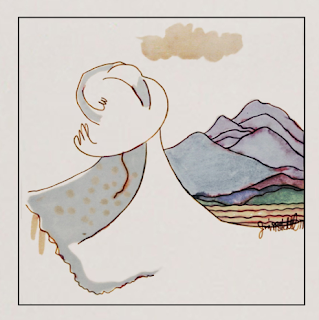 Yet the music is even more interesting than her lyrics (if that is even fathomable). It's impossible to imagine Mitchell’s creative process for writing the songs on Court and Spark (oh to be a fly on the wall on Lookout Mountain Road). Most songwriters begin with a collection of chords and then add a melody that fits, but Joni Mitchell actively avoids any predictable patterns. It's as though the melodies were found first and chords had to be invented to support them. Joni just lets the wind catch her voice as she guides it down through Laurel Canyon to the Sunset Strip to the palm-lined streets of Beverly Hills or the beaches at Malibu, setting it all to musical arrangements that channel Nelson Riddle and Brian Wilson. The songs defy categorization, blending folk, rock, progressive, country, jazz, pop and classical influences in a single track and without the typical verse, chorus, bridge structure. It's exhausting just to list the elements, but they're all there. Tempos, keys and arrangements change randomly and frequently. What should be a mess, ends up mesmerizing. Court and Spark is a musical and lyrical dream.
Yet the music is even more interesting than her lyrics (if that is even fathomable). It's impossible to imagine Mitchell’s creative process for writing the songs on Court and Spark (oh to be a fly on the wall on Lookout Mountain Road). Most songwriters begin with a collection of chords and then add a melody that fits, but Joni Mitchell actively avoids any predictable patterns. It's as though the melodies were found first and chords had to be invented to support them. Joni just lets the wind catch her voice as she guides it down through Laurel Canyon to the Sunset Strip to the palm-lined streets of Beverly Hills or the beaches at Malibu, setting it all to musical arrangements that channel Nelson Riddle and Brian Wilson. The songs defy categorization, blending folk, rock, progressive, country, jazz, pop and classical influences in a single track and without the typical verse, chorus, bridge structure. It's exhausting just to list the elements, but they're all there. Tempos, keys and arrangements change randomly and frequently. What should be a mess, ends up mesmerizing. Court and Spark is a musical and lyrical dream.
The Mountain Loves the Sea, which became the album cover for Court and Spark was done on my land in Vancouver. It was done in a moment of whimsy. It's a metaphor for the way the waves met up with the mountain; the way they embraced one another. - Joni Mitchell
Published on August 23, 2018 06:20
29 Skaters on Wollman Rink
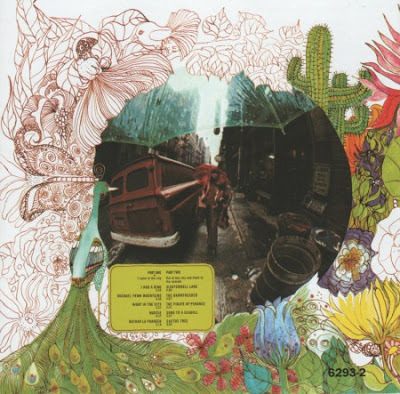 So much about Joni Mitchell can be written about Laurel Canyon, as if she were hemmed in by the Hollywood Hills. And you can certainly see it in her music, from the Sunset Pig to the Valley Barbecues, no other landscape pervades her lyrics in the same way. It's a California spirit from an age (the 60s) when no one was from California. When I was little, the question was always "Where are you from?" The answer, nearly always, was "Back East." (I don't even know if people say "Back East" anymore.) There's an L.A. vibe the pervades her music, in the same way that it furrows into Steely Dan, despite their (Becker and Fagan's) New York sensibilities. Artist's like Andrew McMahon ooze California in the same unmistakable way that The Beach Boys did, but for Joni, that association is truly a misnomer.
So much about Joni Mitchell can be written about Laurel Canyon, as if she were hemmed in by the Hollywood Hills. And you can certainly see it in her music, from the Sunset Pig to the Valley Barbecues, no other landscape pervades her lyrics in the same way. It's a California spirit from an age (the 60s) when no one was from California. When I was little, the question was always "Where are you from?" The answer, nearly always, was "Back East." (I don't even know if people say "Back East" anymore.) There's an L.A. vibe the pervades her music, in the same way that it furrows into Steely Dan, despite their (Becker and Fagan's) New York sensibilities. Artist's like Andrew McMahon ooze California in the same unmistakable way that The Beach Boys did, but for Joni, that association is truly a misnomer.The back cover of Joni's Songs to a Seagull, for instance, is Soho (I'd say Mercer Street). It's interesting how a little enclave south of the Village (not at all trendy in the 60s) was the catalyst for so many photos, from Seagull to Billy Joel. Billy's An Innocent Man album cover was taken at 142 Mercer, at Prince Street.
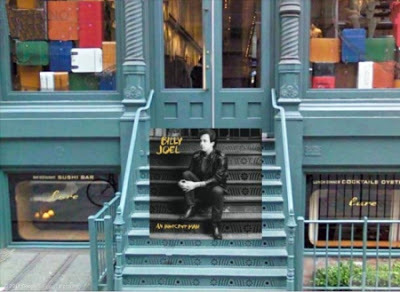 Joni, often pigeon-holed at AM like she was a monument that still stands in the hills of L.A. (I picture the iconic picture of Joni at the house at 8217 Lookout Mountain Rd., as if she were still there, still looking out the window), is, instead, a travelogue. Think of "Morgantown." In my mind, a microcosm of any little town waking up in the morning. I have always been particularly fond of "Morning Morgantown." Joni's lyrics paint vivid images of sleepy people riding around on buses, there are little cafes where you can pass time sipping "tea and lemonade", you might "wink at total strangers passing", and buy "a wooden bird with painted wings." Although Joni confesses she could be describing any town ("Morning any town you name, Morning's just the same"), Morgantown is the one she chose to sing about; it's sounds like the kind of town that I would like to have woken up in, back then. It is, in reality, Morgantown, West Virgina. Maybe it's there that you would find the Barangrill.
Joni, often pigeon-holed at AM like she was a monument that still stands in the hills of L.A. (I picture the iconic picture of Joni at the house at 8217 Lookout Mountain Rd., as if she were still there, still looking out the window), is, instead, a travelogue. Think of "Morgantown." In my mind, a microcosm of any little town waking up in the morning. I have always been particularly fond of "Morning Morgantown." Joni's lyrics paint vivid images of sleepy people riding around on buses, there are little cafes where you can pass time sipping "tea and lemonade", you might "wink at total strangers passing", and buy "a wooden bird with painted wings." Although Joni confesses she could be describing any town ("Morning any town you name, Morning's just the same"), Morgantown is the one she chose to sing about; it's sounds like the kind of town that I would like to have woken up in, back then. It is, in reality, Morgantown, West Virgina. Maybe it's there that you would find the Barangrill.Back in New York, of course, Joni wrote of the big yellow taxis, Checkers, I can only assume, and in case you were wondering, there are 29 skaters on Wollman Rink. The people's party is in one of those beautiful apartments on the West Side.
With "Car on a Hill" and "Down to You," Joni is back in L.A. and I can picture her then, at L.A.'s art deco Union Station leaving, getting on a train, walking by an old man sleeping on his bags. And with the train's breaks complaining, we're once again somewhere else.
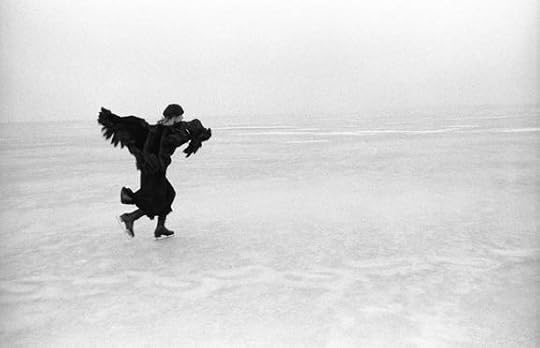
Of course in France, where we can be free, they kiss on Main Street, and Furry sings the blues on now touristy Beale Street. Richard, of course, was last seen in Detroit in 1968. And then there are the places that are only dreams. On "Paprika Plains," which occupied all of side two when Don Juan's Reckless Daughter was released in 1977, we find one of Joni's triumphant works, both lyrically and musically. It flows effortlessly between past and present, childhood and adulthood, earth and sky, innocence and despair. In part it deals with the sad plight of Canada's Indians—romantic figures from her childhood who later "traded their beads for bottles/ Smashed on Railway Avenue/ And they cut off their braids and lost some link with nature." (So we can narrow that down.) It is also concerned with the insecurity of childhood vision and the destruction of the natural world, even "the Godforsaken Paprika Plains."
The scene shifts toward its end to a crowded barroom, in which we hear an instrumental coda by Shorter, Pastorius, Joni and John Guerin that takes us out of the dreamworld, like Van Johnson in Brigadoon, back in NYC. Suddenly, we're all middle aged, with baggage and memories and songs of our youth in a jukebox. Maybe it's that same barroom where Joni puts a dime in a jukebox. She presses D4; it's the Righteous Brothers. For me, I wrap it all up again, maybe at Barney's Beanery on Santa Monica. I can picture it. I know it's wrong, Barney's isn't a Chinese Cafe, but I don't care. Joni, like no other artist, conjures up for me a world that no longer exists. That's what getting old will do.

Published on August 23, 2018 04:41
August 22, 2018
Joni Mitchell and the Kingpin
 In and out of her Laurel Canyon cottage, the kind of place you'd expect Henry Miller, came lovers and other musicians – Graham Nash, James Taylor, Stephen Stills… That folky girl who had them sitting around Indian style singing "The Circle Game" was all grown up, and Blue (AM10) was what she had to show for it. Joni Mitchell's Blue is the perfect album: simple, phenomenal musicianship, a concept, lyrics that unfold on a myriad of levels. The songstress (her voice the most dominant instrument on the album) believes the glass is half-full, but can't help to notice it is also half-empty (and, of course, the glass is refillable); it's that tinge of bitterness that gives each song its edge and scope. Later she'll express it in just one line: "Oh, sour grapes, because I lost my heart" (Court and Spark). Blue is an album culled from the best of the sixties. From "River" to "A Case of You," Joni writes the book on storytelling. There is more than the commonality in titles between this recording and Miles Davis's Kind of Blue. The latter is widely recognized as a high water mark in jazz – a series of modal compositions full of space and economy of delivery. Mitchell, with minimal instrumentation, achieves the same spatial dynamics, compositions that are inventive and sparse. Not to mention lyrics like…
In and out of her Laurel Canyon cottage, the kind of place you'd expect Henry Miller, came lovers and other musicians – Graham Nash, James Taylor, Stephen Stills… That folky girl who had them sitting around Indian style singing "The Circle Game" was all grown up, and Blue (AM10) was what she had to show for it. Joni Mitchell's Blue is the perfect album: simple, phenomenal musicianship, a concept, lyrics that unfold on a myriad of levels. The songstress (her voice the most dominant instrument on the album) believes the glass is half-full, but can't help to notice it is also half-empty (and, of course, the glass is refillable); it's that tinge of bitterness that gives each song its edge and scope. Later she'll express it in just one line: "Oh, sour grapes, because I lost my heart" (Court and Spark). Blue is an album culled from the best of the sixties. From "River" to "A Case of You," Joni writes the book on storytelling. There is more than the commonality in titles between this recording and Miles Davis's Kind of Blue. The latter is widely recognized as a high water mark in jazz – a series of modal compositions full of space and economy of delivery. Mitchell, with minimal instrumentation, achieves the same spatial dynamics, compositions that are inventive and sparse. Not to mention lyrics like… "'I am as constant as the northern star.''Constantly in the darkness; where’s that at? If you want me I’ll be in the bar.'"
That’s TS Eliot or Anne Sexton there; so simply beautiful.
Joni went home after Blue; not California: Canada, and the result, For the Roses (AM8), was like Court and Spark practice; multi-layered madness, crazy harmonies and a myriad of Joni's. Her voice hadn't matured, it succumbed instead to cigarettes, and if chain-smoking ever did anyone justice, well it was us. Side one continues Joni's pre-70s groove, vacillating from love song to social observation with several truly topical pieces. One in particular "Cold Blue Steel and Sweet Fire," describes so beautifully heroin addiction, growing in prevalence in the So. Cal. scene and part of the reason Joni took refuge in Saskatoon. Side one starts off where Blue ended.
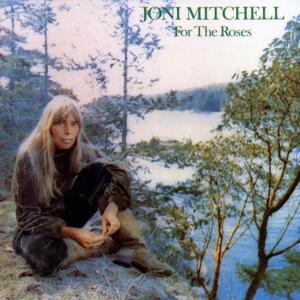 On side two we even get a hit and some radio play, ironically, in "You Turn Me On, I'm a Radio," a song in which it became obvious that Joni would shirk song structure for good, but it's an altogether new magic we find in "See You Sometime" and "Electricity." This is our first glimpse of the inimitable Joni. "Blonde in the Bleachers" is the best song ever written about a rock star on the road. "It seems like you've got to give up such a piece of your soul when you give up the chase," she sings, about finding identity in yourself and meaning in whoever you fuck. The songs weren't protest, they were reflection instead allowing the listener to determine the politicism rather than pounding her over the head with it. The album's standout, particularly in this vein, is "Woman of Heart and Mind:" "Drive your bargains, push your papers, win your medals, fuck your strangers; don't it leave you on the empty side?" It isn't protest, it's a call-out, and so much more effective because of it.
On side two we even get a hit and some radio play, ironically, in "You Turn Me On, I'm a Radio," a song in which it became obvious that Joni would shirk song structure for good, but it's an altogether new magic we find in "See You Sometime" and "Electricity." This is our first glimpse of the inimitable Joni. "Blonde in the Bleachers" is the best song ever written about a rock star on the road. "It seems like you've got to give up such a piece of your soul when you give up the chase," she sings, about finding identity in yourself and meaning in whoever you fuck. The songs weren't protest, they were reflection instead allowing the listener to determine the politicism rather than pounding her over the head with it. The album's standout, particularly in this vein, is "Woman of Heart and Mind:" "Drive your bargains, push your papers, win your medals, fuck your strangers; don't it leave you on the empty side?" It isn't protest, it's a call-out, and so much more effective because of it.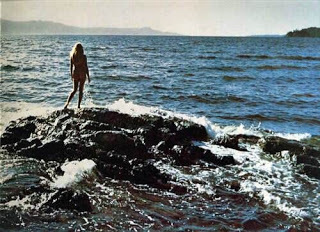 Few artists have more than one AM10, but in less than two years came Court and Spark (AM10). No one anticipated it; it was Blue to the nth degree. It was all of the above plus a jazz army. Court and Spark is gorgeous on every level and marked a new direction, a second wind, Joni’s perfect years; and how many artists are still chasing this dream today? It is the precursor to Aja (AM10) and Sting’s Nothing Like the Sun (AM9), not to mention each successive Mitchell album through Don Juan’s Reckless Daughter. I don’t listen to AM10s much, they carry with them baggage and too much expectation; I have to devote my time, calm my psyche, vacuum first, but I listen to Blue and to Court and Spark. I listen to them all the time. I have "Just Like This Train" on in the background as I write this. Scratch that; it's merely in my head.
Few artists have more than one AM10, but in less than two years came Court and Spark (AM10). No one anticipated it; it was Blue to the nth degree. It was all of the above plus a jazz army. Court and Spark is gorgeous on every level and marked a new direction, a second wind, Joni’s perfect years; and how many artists are still chasing this dream today? It is the precursor to Aja (AM10) and Sting’s Nothing Like the Sun (AM9), not to mention each successive Mitchell album through Don Juan’s Reckless Daughter. I don’t listen to AM10s much, they carry with them baggage and too much expectation; I have to devote my time, calm my psyche, vacuum first, but I listen to Blue and to Court and Spark. I listen to them all the time. I have "Just Like This Train" on in the background as I write this. Scratch that; it's merely in my head.There's something a little dangerous or awry about The Hissing of Summer Lawns. Things have gone terribly wrong in Los Angeles. It's no longer relationships and parties, but drug deals and unhappy marriages; it's the dysfunctional city of Alan Rudolph's Welcome to L.A. Hissing is a much more morose album because of it. "California" has effectively fallen into the ocean (fellow Angelenos will comprehend that allusion). The range of influences is astonishing: the impenetrable-yet-gorgeous "Don't Interrupt the Sorrow" and the greatest song ever written about someone named Edith are so lovely, despite the smog and the cocaine and the infidelity. The recurring lyrical theme is married life in high society, and Joni delivers her brutal verdict in both the title track and the phenomenal "Harry's House." "The Jungle Line", meanwhile, announces an altogether different Joni Mitchell - a purely conceptual piece, lyrically and musically, to the extent that she drowns out her guitar with the drone of a synthesizer and the abstract intellectualism of her words. This song, along with the somewhat pretentious finale, "Shadows and Light," are exhibit A for why this album was a bullseye for reviewers. Nonetheless, time has etched The Hissing of Summer Lawns into my canon, those songs I can hear even when they're not playing ("Songs are like tattoos"). The Hissing of Summer Lawns is an AM9.
 I'm less enamored with Hejira (AM8 - interestingly, this is an LP of which I often contradict myself) and Don Juan's Reckless Daughter (AM7), despite or because of the minimalist approach, and despite, again, the unsurpassed refrains and riffs from Jaco Pastorius. Hejira is a critical feast. Reviewers ate it up, it tops so many of their lists, but when I thumb through my albums, these are not the ones I choose often. Instead, I create a playlist on iTunes: I'll play "Overture/Cotton Avenue" (mostly for that single riff of Jaco's), I'll let it slide into "Talk to Me." Then comes "Refuge of the Roads" and "Coyote." I mix it up a bit. I usually avoid the time consuming "Paprika Plans." These are albums anyone else would be jealous of.
I'm less enamored with Hejira (AM8 - interestingly, this is an LP of which I often contradict myself) and Don Juan's Reckless Daughter (AM7), despite or because of the minimalist approach, and despite, again, the unsurpassed refrains and riffs from Jaco Pastorius. Hejira is a critical feast. Reviewers ate it up, it tops so many of their lists, but when I thumb through my albums, these are not the ones I choose often. Instead, I create a playlist on iTunes: I'll play "Overture/Cotton Avenue" (mostly for that single riff of Jaco's), I'll let it slide into "Talk to Me." Then comes "Refuge of the Roads" and "Coyote." I mix it up a bit. I usually avoid the time consuming "Paprika Plans." These are albums anyone else would be jealous of.It's hard to reach for the 8s and the 7s when an artist has two 10s and a 9. But that's a terrible sentence. Indeed the goal at AM is to put a number on it, yet a sentence like that makes the whole concept seem wrong. Beauty isn't by the numbers, and Joni Mitchell has just one beautiful album after another.
Published on August 22, 2018 04:26



